

Rowan Castle - Travel & Photography

© Rowan Castle 2019


Brazil 2002 - Diary


Day 1 - Saturday 7th September 2002.
The dawn was breaking as our Boeing 777 neared the end of its twelve-hour
flight and began the descent to Sao Paulo, Brazil. The city is one of the World’s
largest, and as I looked out of my window I saw a sprawling urban jungle. Tower
blocks stretched as far as the eye could see, until they merged with the grey
overcast sky.
Once we were on the ground, an announcement informed us that there was a
very violent tropical storm over Rio de Janeiro (our destination) and that we
would be delayed until the airport there could re-open. Immediately, the
prospect of missing our onward flight to Manaus, in the Amazon basin, loomed.
Nothing could be done except to sit tight and wait.
After half an hour, we finally took off on the short flight to Rio. This was a city I
had always wanted to see, but our tight schedule did not allow us any
sightseeing time there. If we were to see anything of the place at all, it would
have to be from the air. However, it was not to be. The tail of the tropical
storm was still over the city, and if anything it was even cloudier than Sao
Paulo. Only the tops of some low mountains were visible.
I had discovered that I was sitting near to two fellow members of the Neblina
expedition. Graham Blackmun, who had done a number of previous trips with
KE was next to me, and in the row ahead sat Brian Cornwell, an experienced
mountaineer who had climbed several Alpine peaks. As we flew low over the
suburbs and looked out on the murky view below, Brian said “So this is Rio,
looks more like Doncaster to me!” We all felt a bit depressed when we realized
that a few factories and warehouses were all we would see of one of the
World’s great cities.
Once we were down on the ground, there was more bad news. We had narrowly
missed our connecting domestic flight to Manaus, and there wouldn’t be
another departure until the evening. We were tired, stuck in an airport and our
travel plans were in disarray. However, we were mistaken to be gloomy. Our
unplanned stop now meant that we had about six hours to explore Rio de
Janeiro! We phoned KE’s agent to let her know what had happened and ask her
advice. She said it might be dangerous for us to go wandering around the city
centre and recommended paying for a taxi to take us on a tour of the sites. So
that’s exactly what we did. As you might expect, we didn’t even have to go
looking for a taxi – a driver with time to spare soon spotted us milling around
and offered us a very reasonable price to take us to the Sugar Loaf Mountain,
and to Corcovado to see the famous statue of Christ.
Soon we were heading away from the airport and through the busy city traffic.
All around we could see evidence of the violent storm that had delayed our
arrival – huge metal advertising scaffolds had been blown over like playing
cards, and uprooted trees littered the streets. We drove past the docks, and
many old colonial buildings with beautiful architecture, before arriving at the
foot of the Sugar Loaf.
From there, we took the large cable car that runs up to the summit. As it left
the base station, we enjoyed great views of the houses and small bay below,
and after only a few minutes we had arrived at the midway station. This sits
atop a smaller conical mountain, very similar to the Sugar Loaf itself. We did
not have much time, and still had to wait for the cable car up to the summit,
but I did get a chance to photograph the small monkeys that lived at the
station, as well as a rock climber who was making his way up the smooth, sheer
face of the rock.
The summit station was extremely windy, so much so that it was difficult to
take photographs without the camera shaking. Although the weather in Rio was
still not brilliant, we did manage to get some very impressive views of the city
from up there, and of the statue of Christ watching over its inhabitants.
View of Rio de Janeiro from the Sugar Loaf.
Back down at street level, we found our taxi waiting for us as promised, and
were soon on our way to Corcovado, to see the statue of Christ close up. As we
drove, I saw road signs that were displaying some very famous names. One in
particular had arrows pointing to Ipanema in one direction (made famous by the
song ‘The Girl from Ipanema’) and Copacabana beach in the other. Eventually
we found ourselves in a quiet suburb, with the road becoming ever narrower. It
then began a long and very steep climb up through the beautiful coastal
rainforest of the Tijuca National Park, until we could drive no further and were
at the steps up to the base of the statue.
The Statue of Christ the Redeemer is huge. It’s hard to appreciate the scale of
it from down in the city, but when you are standing right underneath you can’t
help but wonder how they got all of the materials up to that point to build it.
From the statue, a promontory extended out to a vantage point above the city.
From there it was easy to see the gentle curve of Copacabana beach; Ipanema
and Leblon were also just about visible. We were incredibly lucky with our
timing. We had only been at the viewpoint for around five minutes, and just
retired to a small café at the base of the plinth, when the sky darkened and
enormous storm clouds rolled in. We could see them rapidly shrouding the
mountains up the coast, and then suddenly the café was blasted by very strong
winds.
The Statue of Christ the Redeemer, Rio de Janeiro.
The view of Rio de Janeiro from the Statue of Christ the Redeemer.
After waiting for the maelstrom to subside, we decided to spend the remaining
time until the taxi arrived by walking down the hill to meet it. So we had a
relaxing stroll down the road through the rainforest. For part of the way the
road ran beside the amazing railway that runs up to the statue, via an
incredibly steep track. We saw many interesting birds during the descent,
including a black one with a bright orange crest on its head. All too soon we saw
our taxi coming up the hill towards us, and it was time to head back to the
airport.
Our time in Rio was as brief as it was unexpected and exciting. We had never
imagined that we would be able to spend any time there at all, let alone see its
two most famous landmarks. I hope that one day I will get the opportunity to
return to the city, because it was undoubtedly the most beautiful that I have
seen and there was so much on offer to explore.
Back at the airport, we discovered that our plane would be taking the ‘scenic
route’ to Manaus, because we would be stopping at the country’s capital,
Brasilia, on the way. The flight left on time, but by now it was dark and there
was nothing interesting to see, so I slept most of the way. We were all
extremely tired by now, having had a twelve-hour flight from the UK and then
five hours in Rio with no chance to rest properly or have a shower.
On arrival at Manaus, Walter, one of the Brasil Aventuras guides, met us. He
drove us by minibus to the Ana Cassia Hotel. Although it was late by then, the
streets were not deserted. They were full of teenagers heading out to discos
and nightclubs in the suburbs. As I watched the neighbourhoods flash by, I was
amazed at the scale of the city. It was difficult to remind myself that we were
in the middle of the Amazon Basin.
Once we had checked into the hotel, we met James, our English guide from KE
Adventure Travel. We were all very tired, so after sorting out our baggage, we
went up to our rooms for the night.
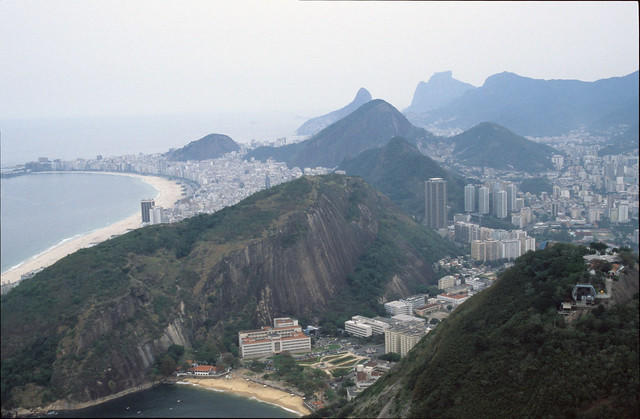
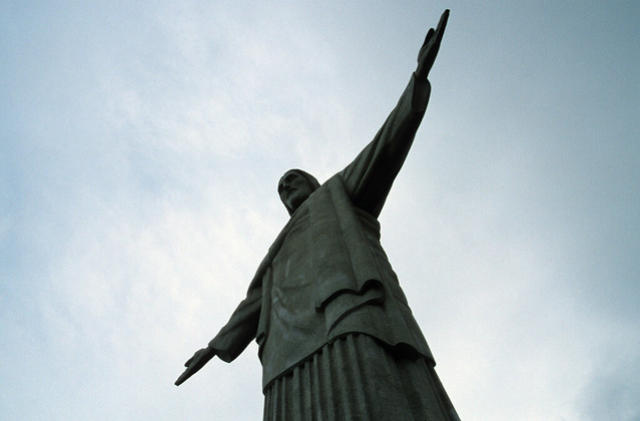

Day 2 – Sunday 8th September.
At breakfast today we met the rest of our trekking party; Bill Scroggie from
Chicago, Del and Carolyn Lane from Colorado and David Holberton from the UK.
This was our free day to explore Manaus and the Amazon, a prospect that we
were all very much looking forward to. Our first trip took us to the Centro de
Instrução de Guerra na Selva (CIGS), which is the Brazilian Army’s jungle
warfare training school. This might sound an unlikely tourist attraction, but the
school has a large zoo that houses animals the soldiers have caught while on
exercise in the rainforest. The animals in the zoo are sometimes used to help to
train the soldiers in jungle survival and hazards. The first animals that we came
to on entering the large zoo compound were the regimental jaguars. Two were
‘normal’ jaguars, and the third was an unusual and rare black jaguar. These
particular animals held a special place in the regiment as mascots, and were
frequently paraded through the streets by their handlers. We were concerned
to see that the pens they were in were very small, and they looked bored.
However, Walter assured us that they were not kept in there all the time, and
were usually housed in a much larger open enclosure (which we saw later on).
He even said that the black jaguar is the friendliest of the three and is very
used to humans!
Further into the grounds we saw some very interesting animals. The most
exciting for me, was the harpy eagle. These are huge birds of prey with long,
dagger like talons. They can swoop down out of the sky and grab monkeys from
out of the forest canopy. The eagle looked down at us with its head tilted right
over to one side, fixing us with its huge dark eyes. It really was a fearsome
creature. I hoped that we would see one during the boat journey to Neblina.
Nearby was another rare and unusual bird, the cock-of-the-rock. These birds
are bright orange in colour, and famous for their courtship displays in rainforest
clearings (known as leks). When I had seen these on TV wildlife documentaries,
I got the mistaken impression that they were small birds, maybe the size of
finches. I later learned that I was very wrong – in actual fact they are more like
the size of a pheasant. Their large size and amazing orange colour makes them
a spectacular sight. There were many other animals on display in the zoo,
including anacondas in a large pond, tapirs, macaws, pythons, two more jaguars
and an ocelot (a beautiful jungle cat, which looks like a much smaller version of
the jaguar). I had mixed feelings seeing these animals in the zoo. It was
fascinating to observe them up close, but at the same time I felt uneasy that
they had been taken from the wild. To be fair, they all looked well kept, and
perhaps the best that can be hoped for is that those who see them will learn to
appreciate the rainforest and the animals that depend on it.
Next, we drove the short distance to the Manaus base of the Instituto Nacional
de Pesquisas da Amazônia (INPA). INPA is a Brazilian government organization
that conducts rainforest research. Once again, we found ourselves in a large
park compound, which contained several animals. Without doubt, the most
interesting of these were the two giant otters. We stood by their pen, and
watched these large but graceful animals swimming up and down in their pool.
They kept their nostrils out of the water, blowing out air to make a ‘chuff-
chuff’ sound. Occasionally they leapt out onto the bank, moving with a funny
loping gait, and showing just how muscular they were. One of the otters dived
down to the bottom of the murky pool and emerged clutching a dead fish in its
webbed paws. With just a few chomps of its powerful jaws and sharp pointed
teeth it had devoured it. These otters are now very rare in the wild, and it was
enthralling to see them up close.
Nearby, in a large tank, swam more extremely rare creatures – Amazonian
manatees. INPA had two at the time of our visit, a mother and calf. This species
of manatee is the only one to be confined to fresh water, and it is believed to
be close to extinction. The tank they were in had large glass side panels, so
although the water was quite murky, occasionally we came face to face with
them.
As we ended our walk around the rest of the park (where we had seen turtles
and bee hives) and were heading to the exhibition building, Bill and I made an
interesting discovery. Hidden at the base of a bromeliad plant was a small bird’s
nest, full of chicks. We both took some photographs, noticing that the change
of light from the flash on our cameras fooled the young birds into thinking that
their parents had returned, and they reared up with their beaks open, hoping
for food.
The exhibition building turned out to be quite small, but did have a very
interesting display of different types of rainforest seeds, leaves and wood
samples. There were also satellite photographs on the walls showing Manaus
and the surrounding rainforest.
Leaving INPA behind, we were driven out to the banks of the Rio Negro. We
arrived at a dusty and rubbish strewn jetty, where the passenger ferries that ply
the Amazon were moored. Far out in the wide river, large tankers were at
anchor, while a little way downstream from us, a huge car transporter was
being unloaded. The decks of the ferries were crowded with hammocks, where
people sleep during the long river journeys. We would soon be flying to Sao
Gabriel da Choeira, but the same journey by ferry takes nine whole days.
Turning away from the hubbub at the waterfront for a few minutes, we took a
look at a nearby fish market. Of course, I found it impossible to recognize the
different species of Amazon fish that were on offer.
Riverside fish market at Manaus.
Passenger ferries at Manaus.
Walter cast his expert eye over the many water taxis that were moored at the
jetty, and only started negotiating with the boatman once he had found one
that met with his approval. The boat would be taking us out to a floating
restaurant for lunch.
We had only just cast off, when we made an interesting re-fuelling stop at one
of the large floating petrol stations on the river. Our tanks were filled using
exactly the same sort of petrol pump that you would see at a roadside filling
station. It seemed that the taxi-boatmen could not afford to refuel their boats
until they had a paying fare.
At the floating restaurant we saw an interesting sight. A group of Indian boys
had gathered at the shore. We were talking to them when another boat
appeared. Among the passengers was another Indian child, holding what I
initially thought was a teddy bear. As the boat moored up, I suddenly realised
that it was not a teddy bear at all, but a sloth that was being kept as a pet.
Flooded rainforest near the floating restaurant, Manaus.
After lunch we were taken out in the boat on to the river again, to see the
‘meeting of the waters’ where the Rio Negro joins with the Rio Solimoes to
form the mighty Amazon River. The two rivers are different colours – the Rio
Negro is dark brown due to the tannins from the vegetation and soil in the
rainforest of the Amazon basin, whereas the Solimoes is grey from sediments
carried down from the Andes. When the two bodies of water come together it
takes a while for the colours to mix, which is a very strange sight.
Having had a very enjoyable introduction to the Amazon River, we were taken
back to the Ana Cassia Hotel.

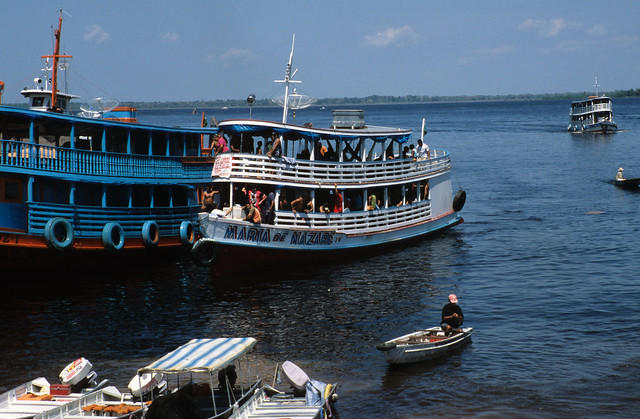

Day 3 – Monday 9th September.
We checked out of our hotel early, and were driven to the airport for our flight
to Sao Gabriel da Cachoeira on the Rio Negro. Walter helped us through the
airport, making sure that everything went smoothly, before we said our
goodbyes and boarded the plane. The aircraft was a Brazilian Embraer 120, a
fairly small twin-turboprop.
I had a good window seat next to one of the wing-mounted engines, and had
superb views of the Amazon rainforest as we climbed up to about 20,000 feet.
Apart from the immediate vicinity of Manaus, there was little sign of
deforestation on the flight. The trees stretched unbroken to the horizon in
every direction, and the forest appeared so vast that it seemed inconceivable
that man would be capable of chopping and burning it completely. We over-flew
several rivers, the sun glinting off the water as it twisted and looped in great
meandering turns through the trees, occasionally leaving ox-bow lakes stranded
along the way. This was not like the rainforest I had trekked through in
Venezuela, where gallery forest and small hills occasionally gave way to patches
of bare savannah and tepui mountains, this was the huge low-lying Amazon
Basin.
Flying from Manaus to Sao Gabriel da Cachoeira.
Reaching Sao Gabriel, a sharp peak reared up from the forest, and the Rio
Negro, inky black from the tree tannins that had leached from the forest,
tumbled over wide and impressive rapids. Our aircraft dipped lower and lower
towards the rainforest canopy, and just as it seemed we would land in the
treetops, the green of the forest gave way to a tarmac runway and we
shuddered to a halt. In just a few days, we had flown from London, right down
to Sao Paulo in the Southern Hemisphere, and now we had gone all the way
back to just south of the Equator.
Once inside the small terminal building, we met our Brazilian guides for the
actual trek, Marcello and Valdir. Marcello was the senior of the two guides. He
was a big man, with long hair tied back in a ponytail. Originally from the city of
Belo Horizonte, most of his outdoors experience had been rock climbing in the
mountains near to his home. He loved the jungle however, and was an
accomplished photographer. During the trip, he showed us an article about the
Pico da Neblina trek that had appeared in a Brazilian magazine, illustrated with
his photographs. He had already guided Neblina five times, and our trip was to
be his sixth. Unfortunately, Marcello spoke only a few words of English, so his
main role was coordinating the logistics of the trip. Communicating with the
rest of the party, and with James, our English guide, was the job of Valdir, the
second guide. Valdir (Val) was a local man, and had a small ranch of 200 cattle
in Sao Gabriel. As a young child, he had been to school in Beverly Hills,
California, and spoke excellent English. It’s fair to say that Valdir was the
complete opposite of Marcello, he was always telling a story, cracking a dirty
joke or playing a prank on someone, whereas Marcello was usually quieter and
more serious. Val was 59 years old at the time of our trek, and the son of a
Portuguese father and Brazilian Indian mother. He was a very experienced
bushman, and had some amazing stories to tell. For example, about four or five
of Val’s top front teeth were missing, and he had a dent in the back of his skull.
This had happened when he was earning a living by diving for treasure and
salvage off the Venezuelan cost. This is notoriously dangerous at the best of
times, but Val had the especially perilous job of operating a huge vacuum pump
that sucks the gravel off the seabed to (hopefully) reveal buried treasure. One
day, as he was doing this, a large rock became dislodged above him, struck him
on the back of the head and knocked him unconscious. This knocked out his
front teeth, but amazingly, the weight of the rock pressing down kept his air
supply from falling out of his mouth. He lay unconscious on the seabed for ten
minutes before being rescued! Like Marcello, Val had climbed Neblina many
times, and knew the route like the back of his hand.
Having collected our backpacks, we set off into town. We had lunch at a
colourful roadside café, and then went to the FUNAI office. FUNAI is a Brazilian
government organization that aims to protect the country’s indigenous Indians.
Before we were allowed to set foot in the Pico da Neblina National Park, we had
to fill out our passport details in the register. As I waited outside in the small
garden, I saw a bird with black or brown wings and the most incredibly bright
golden rump and tail. Val told me that it was a yellow-rumped cacique and that
they are not uncommon in Sao Gabriel.
Before we set off on our adventure, we stopped at the Sao Gabriel office of
Brasil Aventuras, where we were able to leave any equipment that we did not
need to take into the rainforest. Bill was quite worried about the size and
weight of his rucksack, and asked me to help him get rid of anything he
wouldn’t need. We went through the whole thing, and probably reduced the
bulk and weight by at least a third. I got on well with Bill during the trek,
because I soon found that he had a great sense of humour and rarely grumbled
about anything.
As the final preparations for departure were made, and our baggage was being
loaded onto the truck, I went a little way down the hill to a point where the
road overlooked the Rio Negro, to take some photographs. I was right above the
impressive rapids that we had seen from the air, and these surged past a wide
beach of golden sand. In the distance I could see the green forest, and an
abrupt range of hills. Sao Gabriel really was a charming Amazonian town.
The Rio Negro at Sao Gabriel da Cachoeira.
Back at the truck, we had a pre-departure briefing from Marcello and Valdir.
They warned us that the rainforest could be dangerous, and that we should not
wander off alone. There were many jaguars where we were going, they said,
and one of the big cats had recently killed a Yanomami Indian. Of course, it’s
impossible to never be alone in the rainforest, and Valdir’s warning about
jaguars would often come back to haunt me in the days ahead, especially when
I had to go out of the camp at night to go to the toilet!
At last, it was time to set off. Most of the group were sitting up on the back of
the truck, using planks as seats. It was cool up there, and good views were to
be had of the forest, but there was no legroom and no escape from the blazing
sun. I started the journey sitting in the cab, next to the driver. There was lots
of legroom and it was out of the sun, but the heat was stifling! At first we drove
a short distance out of town along a metalled highway, until we came to a large
rubbish dump, and turned onto a wide dirt road. This road ran north through
the jungle, all the way to the border with Colombia, but we would only be
going as far as a bridge at Lamarim Creek (pronounced YA-ma-rim). The land
either side of this stretch of road that was close to Sao Gabriel had been
deforested and cleared for pasture or the occasional house. There were large
areas where only the broken and burnt stumps of trees remained, and in others,
tracts of grassy swamp. As we went further along the road, the forest closed in
on either side. Our truck passed through large clouds of yellow butterflies, and
we saw Toucans dart overhead, with their characteristic undulating flight. Val
spotted an agouti (a large fruit eating rodent) far ahead on the road in front of
us and pointed it out.
During the journey we crossed the equator, passing from the Southern to the
Northern hemisphere. The equator itself was marked by a large sign at the side
of the road.
The further we went, the worse the condition of the road became. The lack of
drainage meant that there were numerous sections that were very badly rutted
and almost impassable. Only four-wheel drive vehicles could make the journey
to Lamarim Creek. By now, I had traded places and was riding on the back of
the truck, and at each rutted section we had to climb down from our planks to
lighten the load on the vehicle, and enable it to plough through at speed. We
did this many times, rejoining the truck on the other side of each quagmire.
An unexpected stop came when one of the seat planks snapped in two. Luckily,
there was a pile of timber lying on the road nearby, and our driver made
incredibly short and accurate work of cutting a new plank to exactly the right
size with his machete. He was able to hit the same cut with each swing of the
blade.
We suddenly came across a large Brazilian army Mercedes truck, stuck up to its
axles in a particularly boggy section of the road. In the back of the covered
wagon, there was a large wooden boat. By pure co-incidence, the soldiers were
on their way to the summit of Neblina as well. We had stumbled on the annual
Brazilian army expedition which checks that the Brazilian flag flies at the top of
the peak, and carries out any necessary repairs. The soldiers were busy trying
to dig themselves free, and one was underneath the lorry shoveling earth out
from under the axle. Marcello, Val and the driver fetched shovels and a pickaxe
from the back of our truck and began chopping out clods of the thick orange
earth and laying it in the ruts. They filled in the deepest grooves with branches.
Thanks to their efforts our truck got straight across at the first attempt.
The Brazilian Army unit dig their truck out of the mud.
At last we reached Lamarim Creek, and the truck pulled off the main road and
into a clearing by the river. Moored at the bank was the large wooden boat that
we would be using to travel upstream to the foot of Neblina, already loaded
with our expedition supplies and equipment. Nearby was an open sided, wooden
shelter that is used as a trading post by the Yanomami. Our Yanomami porters
and boatman had slung their hammocks inside and been waiting for our arrival.
Now they quickly came down to the creek bank to greet us.
It was already late afternoon, so it was important that we wasted as little time
as possible; we loaded our rucksacks into the boat, climbed aboard and shoved
off into the creek. The river was narrow at first as it twisted between the trees.
Already the evening light was dim under the shade of the canopy. Marcello was
sitting just in front of me, and we noticed that a large praying mantis had
landed on his baseball cap. The insect was standing on its back legs in the
famous mantis pose and every time our boat went round a corner it would
actually strain its head to one side to see where we were heading! We also saw
a couple of large blue morpho butterflies gliding between the tree trunks,
perhaps looking for a place to shelter for the night.
Our boat at Lamarim Creek.
In the failing light, we emerged from the trees where the Lamarim joined the
larger and wider La Grandi River. Turning to the right, we motored downstream
towards our camp. Just before nightfall, we were lucky to see a small troop of
uacari monkeys leaping through the treetops.
Darkness fell and we were treated to a spectacular starry sky with a bright
crescent moon. It was very atmospheric to be ploughing on down the river
through the inky blackness – but as Del rightly pointed out, quite dangerous.
We could easily have become snagged on submerged branches or hit some other
obstacle, but there was no alternative but to carry on until we reached our
campsite. As we glided along, we sometimes saw bright white flashes of light
coming from the trees on the riverbanks. Valdir revealed that these were
fireflies. It was interesting to see that these gave off a white light, rather than
the green glow of the ones I had seen in Venezuela.
At the confluence of the Ya Grandi and Cauaburi Rivers, we reached our camp
for the night. It was a hut that served as a guard post for FUNAI – everyone
traveling on the river had to report here before setting off up the Cauaburi into
the Yanomami areas. Confusion reigned as we scrambled ashore in the darkness
and unloaded our packs onto the low flat rock that jutted out from the high
bank. A short but steep climb up a muddy path brought us to the large hut,
which was raised off the ground on short wooden stilts. It stood back from the
riverbank, in a wide clearing, surrounded by dense rainforest. Next to the river
was a small stand of tall palm trees, and we were told to sling our hammocks
between them. Valdir then gave us all a short lesson in how to tie them
securely, using simple knots. I made sure that I rigged my mosquito net to hang
down around my hammock. It was a wise precaution – the next day Valdir told
us that the owner of the hut had recently lost twelve chickens to vampire bats!
Before long our dinner was ready, and we ate it sitting on low wooden benches
next to the hut. On the far side of the clearing, our Yanomami porters were re-
heating some meat from a tapir that they had caught some time before.
After dinner, I made my way a little distance into the trees to go to the toilet.
As I ducked under the tangle of branches, I was startled when I heard the heavy
steps of a fairly large animal galloping away into the forest. When I mentioned
it to Valdir he said that it was probably a pacca. Before turning in for the night,
I went down to the rock shelf by the river to wash and fill my water bottle. As I
stood there, a huge and spectacular moth flew out of the gloom, attracted by
my head-torch. It flapped clumsily in my face for a few seconds, and then went
on its way.
Valdir had decided there was no chance of rain that night, so there was no
tarpaulin above our hammocks. As I lay in mine, I had a wonderful view up
through the fronds of the palm trees, with the stars twinkling overhead. Every
now and then I saw the dark shape of a bat flitting past. It was so quiet and
peaceful that I was asleep in no time at all.


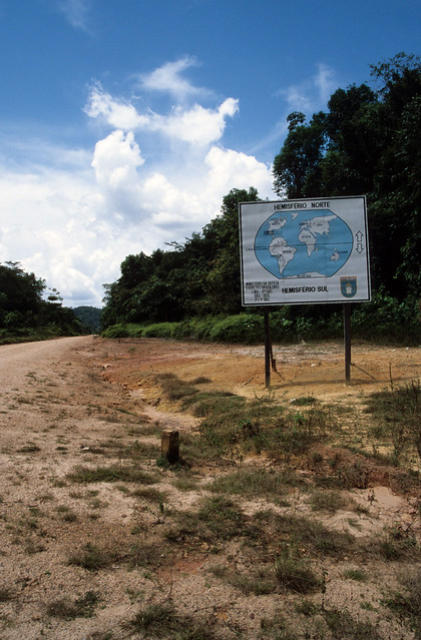
Crossing the equator.
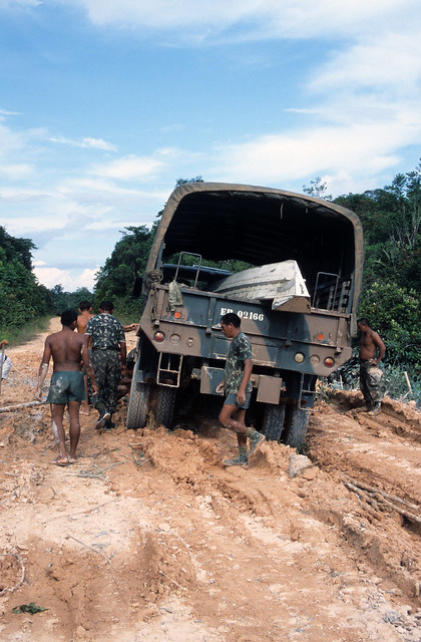
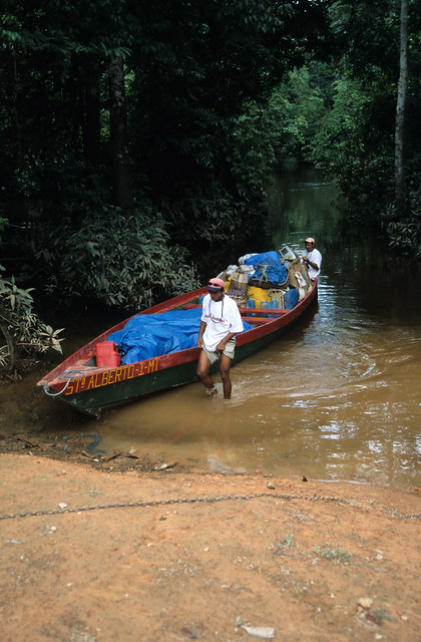
Day 4 – Tuesday 10th September.
We woke at dawn, and were treated to a beautiful sunrise that was reflected in
the waters of the Cauaburi. The full-length carbon fibre tripod that I had
brought on the trip proved it’s worth straight away, and I was able to get some
good photos.
Sunrise on the Cauaburi River at Camp One.
The FUNAI post (Camp One) on the Rio Cauaburi.
We were away by around seven o’clock, traveling upstream, along the Cauaburi.
We passed many sandbanks on the way, often startling clouds of yellow
butterflies into the air. They had been feeding on the nutrients from the damp
sand near the water’s edge.
At about ten o’clock, the boat was moored at ‘Jaguar Beach’, so called because
a jaguar had sometimes been glimpsed there on the wide sandy shore. Bill and I
took the opportunity to go for a swim, and while we were in the water, rare and
elusive pink river dolphins began to surface and bow-wave further out in the
river behind us. It was an incredible few minutes; although we had only just
begun our jungle journey we had already seen some impressive wildlife. After
drying off on the beach, I had a mid-morning snack of tapir meat. It was the
first time I had ever tried it, and I found it to be very tender and tasty.
Later on that morning, as we continued motoring up the river in the boat, we
were fortunate to glimpse a pair of giant river otters bobbing in the water far
behind us. It was just possible to see the whiter fur on their throats that
identified them. Although they were only visible for a few seconds, their
appearance caused a buzz of excitement around the boat. We were very
privileged to have seen them, as they are now so rare in the wild.
The river became much shallower as we got further upstream, and this slowed
us down considerably. Our boatman had to exercise great care to weave the
boat around semi-submerged trees, branches and large rocks. The lack of
progress caused difficulties within the group because we were becoming unsure
of the schedule and timescales involved in getting to the mountain.
Later on in the afternoon, we pulled in to the bank and moored at a Yanomami
travelling encampment – a basic campsite that the Indians use while moving
through the forest. Our porters and Val got out of our boat to visit the camp and
give them some batteries. I wasn’t sure if we would be allowed up to the camp
or what sort of reception we might get, but James said he thought there was no
problem. So Bill and I cautiously followed Val out of the boat, walked along a
thin log and then climbed the steep bank up into the trees. I deliberately left
my camera in the boat, as I did not want to cause any offence. There were
three open-sided huts in the small clearing, with the occupants lying inside in
their hammocks. Under the carefully woven roof of one hut, they were roasting
pacca, bush fowl and some fish. Stacked neatly in another were bundles of
jungle vines that the Yanomami sell to traders, and they are eventually made
into yard brushes. Nearby, impaled on an upright wooden stake was the empty
and sun-bleached shell of a large river turtle.
Back on the river, we found ourselves passing several Yanomami plantations. At
one of them Val pointed out the tree from which Yopo is made. Yopo is a very
powerful hallucinogenic snuff drug that the Yanomami use. Traditionally one
Indian would blow the drug forcibly up the nostril of another, using a blow tube
made from bone. The drug produces powerful hallucinations, and also
commonly makes the user vomit copiously.
From the river we now had great views of Padre Peak; a nearby mountain that
got its name from its resemblance to a priest lying down with his hands clasped
in prayer above his chest. We also began to see the first of many scarlet
macaws, often flying in trios and squawking loudly as they made their way
overhead.
On the Rio Cauaburi, with Padre Peak behind.
At around six o’clock we reached Maria camp. It was a beautiful place, with a
wide sandy beach and a narrow path that lead up to several old Yanomami huts
in a clearing. From the beach there was a nice view of Padre Peak rising up
above the dense rainforest on the opposite bank. We soon discovered that we
were sharing the camp with the Brazilian Army squad we had seen on the road.
There was not much time before darkness fell, so we quickly slung our
hammocks inside one of the huts, while a few in the group chose to sleep on the
beach under the stars. I lay down in my hammock until our dinner was ready,
and after that I went to sleep. There were many bugs inside the hut with us,
but we managed to get a fairly good night’s rest.
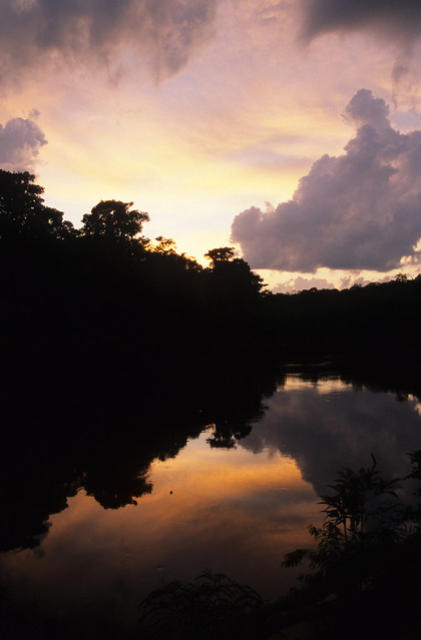


Day 5 – Wednesday 11th September.
The huts at Maria Camp.
Today was our last on the Cauaburi. We made an early start, and found that the
army team had already motored away up the river. It was important that we got
going quickly, to try to make up for time lost due to the shallow water.
As we took our places in the boat, it was my turn to sit on the back row of seats
and help James to bail the water where necessary. Unfortunately we did not
make good time. Once again the river was extremely shallow, and our boatman
used great skill with the throttle and rudder to keep us moving smoothly
upstream. Occasionally a blue morpho butterfly drifted past us, flashing like a
blue laser as its wings caught the sunlight. Where the rainforest on either side
began to thin out into stands of palm trees we began to see many more
macaws, both the scarlet and blue-and-yellow species. They were always a
noisy and incredibly colourful spectacle.
A couple of hours after setting out, we came to the mouth of the Maturaca River
and met the Chief of the Maturaca Yanomami village, who came out in his
aluminium boat to meet us. He had come to collect some supplies that we were
carrying for him. He shook hands with each one of us in turn, and then went on
his way, back up the Maturaca.
We carried on up the Cauaburi until we reached a large rock in the middle of
the river. Just around the corner from this was the mouth of Tucano Creek – the
gateway to Pico da Neblina. As soon as our boat turned into the narrow creek,
we ran aground on some submerged branches. Once we had cleared these we
became lodged on a sandbank. Val, the porters and a few of the trekking party
jumped out and pushed the boat upstream from this point. After about twenty
minutes we arrived at a low bank on the left hand side and Val told us we had
arrived. We ate a very hurried lunch, re-arranged our packs ready for the trek,
and set off into the forest. After walking for just one hundred yards or so,
James and I saw a huge blue morpho butterfly perched next to us in a tree.
The walking pace that Val set was very fast, right from the beginning. At every
opportunity he reminded us to hurry, otherwise we would not make it to our
camp before nightfall. We came to a thin three-log bridge over a gully, with a
drop of four or five feet below. I crossed without any problems, and Carolyn
followed me over. However, when David was right in the middle the bridge gave
way and he took a bad fall. As he landed at the bottom of the gully, he hit his
head on a branch. We were all very concerned, but luckily David was fine; even
his glasses were still intact.
We made it into the camp just as night was falling. Once again we found that
our accommodation was an old Yanomami travelling encampment. We put up
our hammocks and mosquito nets inside the huts, and then tucked into a dinner
of beans, meat, eggs, rice, manioc and onions.
After dinner, I was looking for a place to go to the toilet. I thought I had found a
good spot and ducked down to get under the leaves of a banana tree, but as my
head-torch illuminated a fallen tree ahead, I got a shock. There was an
enormous tarantula resting on the trunk, waiving its front legs menacingly in
the air. I hate spiders, and for a few seconds I was frozen to the spot. Some
tarantulas can jump, and I had nightmare visions of it leaping at me and
clamping itself onto my face. However, once I realized that it wasn’t going
anywhere fast, I called out loudly to the rest of the group to come and have a
look at it. They were all just as amazed and impressed as I was, and many
people in the group took photos of it.
Once the tarantula drama was over, we all turned in for the night, only to find
that more fun with the wildlife was in store. We discovered that bats had been
roosting in the hut where we had set up our hammocks, and they were flying in
and out as we tried to sleep. I got quite a shock when one of them collided with
my mosquito net, and hit me in the side of the head! A little while later I
switched on my head-torch and noticed that I had a smaller visitor – a little
green gecko that was perched on the top of my mosquito net.
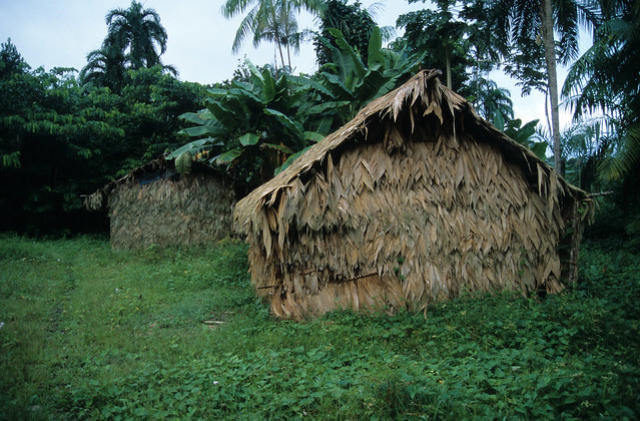
Day 6 – Thursday 12th September.
We all knew that today would be a long haul, because we had to make up for
the slow progress in the boat. Val said that we were approximately two hours
behind schedule and should expect to walk for eight to ten hours.
Setting off at around 06:20, we forded a fairly wide river immediately after the
camp and then found that the track was mainly a steep slog uphill. It was very
humid, and we all had to drink a lot of water to stay hydrated. There were
plenty of unusual things to see during the climb. We passed a beautiful blue
flower that was growing from the trunk of one sapling. At one of the rest stops,
Val found a quinine tree – used to prevent malaria. He cut off a small piece of
the bark for me to taste. It was very bitter, and even after I had spat it out, the
taste lingered on for a few minutes.
The blue flower we found in the rainforest.
We stopped for a rest and a mid-morning snack at the site of an old framework
shelter. During the morning, we had often seen little piles of excavated dirt and
mud on the track, which Val said were the casts from tunnels made by giant
earthworms. While we were at the rest stop, Pepe (one of our porters) actually
caught one to show us. It was approximately the thickness of my thumb, orange
in colour and at least a few feet long. I had no idea that worms as big as this
even existed, and Val assured us that this was a fairly small specimen.
Apparently they actually make quite a good meal, but even so, we were all glad
that Pepe let the worm go unharmed.
Pepe with the giant earthworm.
The lunch stop was made in a small clearing, where we feasted on bread, soft
cheese, salami and banana cake. This was more or less what we had for lunch
every day on the trek and boat journeys.
The afternoon was very hard work, as the track continued steeply uphill through
the rainforest. Many of the plants and trees (especially the palms) had wicked
spikes on their trunks or leaves that had to be avoided. Often Val would shout
out a warning from the head of the group, which we had to pass down the line
to the back. It rained hard in the afternoon, but we all found the downpour very
refreshing as it gave us some relief from the heat and humidity.
We arrived at Bebedo camp at 15:30, which was earlier than had been
anticipated. Everyone was in a good mood now that we were back on schedule
and the uncertainty of river travel was behind us. The Brazilian army group had
taken residence in the existing shelter, but fortunately our porters had been
well ahead of us on the trail and had nearly finished the construction of a new
one for us to sleep in. While they finished it off, we all took a short walk down a
nearby trail to the river and had a swim. Unfortunately, as I was making my way
barefoot down the slimy rocks to the water’s edge, I slipped. My foot shot out in
front of me, into a gap between two stones and then was abruptly stopped by
the face of a larger rock. I stubbed my big toe very badly, and it began to bleed
from the side of my toenail. It was very painful and it did not heal for the rest
of the trek because my toe was always exposed to the damp and lack of air
inside my walking boots. I was worried that it might get badly infected, but
luckily that didn’t happen. The swim in the river was fantastic and very
refreshing after the long hard walk.
Back at camp, we noticed a very large stick insect that was hanging from one of
the leaves of a nearby banana tree. After dark, Valdir found a medium sized
tarantula in the leaf litter of the clearing and warned us that there were
probably more around.

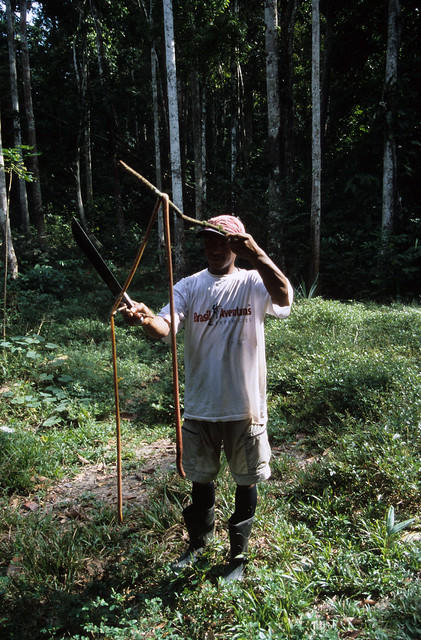
Day 7 – Friday 13th September.
After a good night’s sleep in our most comfortable camp yet, we had a breakfast
of porridge and then set off up the trail. Almost immediately we began a harsh
uphill climb through the forest once again. Valdir found a dazzling forewing
from a blue morpho butterfly lying in the leaf litter and also showed us a tree
with sap that had oozed from its trunk and solidified. He told us that these solid
white chunks are flammable and that the Yanomami often collect it to use for
lighting fires. There were many other rare and unique plants on these slopes, he
told us, and he had recently guided a botanist to the slopes of Pico da Neblina.
With the help of Yanomami porters, the botanist had collected many kilos of
plant specimens and taken them back to Brazilia for analysis in the laboratory.
He had been looking for new chemicals that could be used as natural insect
repellants and in the treatment of cancer.
We had our lunch at a creek bed that was almost dry. There was just a tiny
trickle of water flowing from a nearby bank, from which we re-filled our
depleted water bottles. The trail followed the creek bed uphill for a few
meters, before turning to the right and taking us back into the forest. The going
was now very steep, and made more difficult by the large number of slippery
roots under foot. Gradually, the mud gave way to chunks of brilliant white
quartz rock and the forest changed from trees to palms, bromeliads and ferns.
The path appeared to be following the crest of a ridge.
Suddenly and without warning, we found ourselves at the top of the pass and
looking out through ‘windows’ in the forest. Below us was an incredible view



















